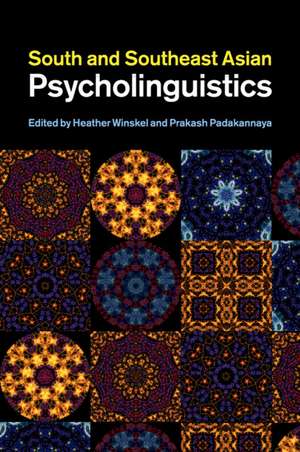South and Southeast Asian Psycholinguistics
Editat de Heather Winskel, Prakash Padakannayaen Limba Engleză Paperback – 11 dec 2019
Preț: 358.87 lei
Nou
Puncte Express: 538
Preț estimativ în valută:
68.67€ • 71.88$ • 57.15£
68.67€ • 71.88$ • 57.15£
Carte tipărită la comandă
Livrare economică 31 martie-14 aprilie
Preluare comenzi: 021 569.72.76
Specificații
ISBN-13: 9781108790390
ISBN-10: 1108790399
Pagini: 489
Ilustrații: 44 b/w illus. 50 tables
Dimensiuni: 228 x 151 x 25 mm
Greutate: 0.65 kg
Editura: Cambridge University Press
Colecția Cambridge University Press
Locul publicării:Cambridge, United Kingdom
ISBN-10: 1108790399
Pagini: 489
Ilustrații: 44 b/w illus. 50 tables
Dimensiuni: 228 x 151 x 25 mm
Greutate: 0.65 kg
Editura: Cambridge University Press
Colecția Cambridge University Press
Locul publicării:Cambridge, United Kingdom
Cuprins
Introduction Heather Winskel; Part I. Language Acquisition: Section 1. Spoken Language: 1. Studying language acquisition cross-linguistically Sabine Stoll and Elena Lieven; 2. Infant directed speech: social and linguistic pathways in tonal and non-tonal languages Christine Kitamura; 3. Pragmatic development of Mandarin-speaking young children: focus on communicative acts between children and their mothers Jing Zhou; 4. Referential forms in Thai children's narratives Theeraporn Ratitamkul; 5. The acquisition of tense and aspect Yasuhiro Shirai; 6. The acquisition of Malay numeral classifiers Khazriyati Salehuddin; 7. The acquisition of Vietnamese numeral classifiers Jennie Tran; 8. An overview of the acquisition of Malay wh-questions Norhaida Aman; 9. Marking plurals: the acquisition of nominal number inflection in Marathi Shalmalee Pitale and Vaiyayanthi M. Sarma; 10. Issues in the acquisition of Tamil verb morphology Vaijayanthi M. Sarma; 11. Fast mapping of novel words in bi/multilinguals Vishnu K. K. Nair, Sunil Kumar Ravi, Sapna Bhat and Shyamala K. Chengappa; 12. Studies on the acquisition of morphology and syntax among Malay children in Malaysia: issues, challenges and needs Rogayah A. Razak; 13. Issues in developing grammatical assessment tools in Chinese and Malay for speech and language therapy Lixian Jin, Rogayah A. Razak, Jannet Wright and John Song; Section 2. Written Language: 14. Reading and reading acquisition in European languages Brian Byrne, Stefan Samuelsson and Richard K. Olson; 15. Learning to read and write in Thai Heather Winskel; 16. Learning to read and write in Indonesian/Malaysian: a transparent alphabetic orthography Heather Winskel and Lay Wah Lee; 17. Literacy in Kannada, an alpha-syllabic orthography R. Malatesha Joshi; 18. Reading in Tamil: a more alphabetic and less syllabic akshara based orthography Bhuvaneshwari B. and Prakash Padakannaya; 19. Akshara-syllable mappings in Bengali: a language-specific skill for reading Shruti Sircar and Sonali Nag; 20. Diversity in bilingual children's spelling skill development: the case of Singapore Susan Rickard Liow; Part II. Language Processing: 21. Tones and voice registers Arthur S. Abramson; 22. How to compare tones Nan Xu, Virginie Attina, Benjawan Kasisopa and Denis Burnham; 23. Studying sentence generation during scene viewing in Hindi with eye tracking Ramesh Mishra; 24. Thai specific and general reading processes in developing and skilled Thai readers Jeesun Kim and Chris Davis; 25. Eye movement guidance in reading unspaced text in Thai and Chinese Jie-Li Tsai; 26. SE Asian writing systems: a challenge to current models of visual information processing in reading Ronan Reilly; 27. Preferred argument structure and Thai varieties of English: evidence of cognitive processing limitations? Thom Huebner; 28. Cross-language perception of word-final stops Kimiko Tsukada; 29. Uncovering bilingual memory representations Winston D. Goh, Lidia Suárez and Kelly Yeo; 30. Eye movements and reading in the alphasyllabic scripts of South and Southeast Asia Heather Winskel, Prakash Padakannaya and Aparna Pandey; Part III. Language and Brain: 31. Aphasia to imaging: the neurolinguistic endeavor as it reflects on South and Southeast Asian languages Loraine K. Obler and Avanthi Niranjan Paplikar; 32. Neural bases of lexical tones Jackson T. Gandour and Ananthanarayan Krishnan; 33. Hemispheric asymmetry in word recognition for a right-to-left script: the case of Urdu Chaitra Rao, Jyotsna Vaid and Hsin-Chin Chen; 34. The declarative procedural model of language: a new framework for studying the non-inflecting languages of Southeast Asia? Tomasina Oh; 35. Language mixing in bilingual aphasia: an Indian perspective Sapna Bhat and Shyamala Chengappa; 36. The relationship between language and cognition Heather Winskel and Sudaporn Luksaneeyanawin.
Recenzii
'The 'anglocentrism' of traditional psycholinguistics has undermined a full understanding of both the universal and language-specific aspects of language processing. This book provides a desperately needed remedy, an invaluable resource on language processing in some of the richest and most diverse languages spoken by millions of people.' Johannes Ziegler, CNRS and Aix-Marseille University
Descriere
This book raises new questions in psycholinguistics and enables readers to re-evaluate previous models in light of new research.
